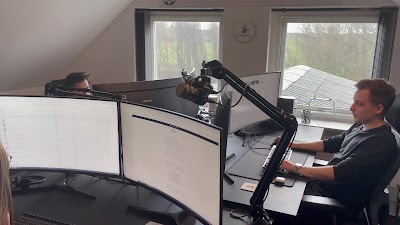Jake Sullivan spent $3,000 on Google Ads last month and got exactly two phone calls. Both customers wanted estimates for small repairs under $500. Meanwhile, his competitor down the street landed three major roof replacements worth $45,000 total from the same advertising platform.
What made the difference? Jake’s competitor understood something crucial about Google Ads for small roofing businesses that Jake didn’t.
Most small roofing contractors approach Google Ads with unrealistic expectations and poor strategies. They throw money at broad keywords, create generic ads, and wonder why their investment doesn’t pay off. When results disappoint, they conclude that Google Ads isn’t worth it for small roofing businesses.
The truth is more nuanced. Google Ads can be incredibly profitable for small roofing companies, but only when implemented correctly. Success requires understanding your local market, targeting the right customers, and managing campaigns strategically rather than hoping for instant results.
This comprehensive analysis reveals whether Google Ads is worth it for your small roofing business. You’ll learn the real costs, realistic ROI expectations, and proven strategies that separate successful advertisers from those who waste their budgets on ineffective campaigns.
The Real Cost of Google Ads for Small Roofing Businesses
Understanding Keyword Costs in Roofing
The first question most small roofing contractors ask is whether Google Ads is worth the cost. Roofing keywords are among the most expensive in Google Ads because they represent high-value services that customers need urgently.
Average cost-per-click for roofing keywords ranges from $15 to $75 depending on your location and competition level. Emergency repair keywords like “roof leak repair” or “emergency roofer” often cost $25 to $50 per click in competitive markets. Roof replacement keywords can exceed $75 per click in major metropolitan areas.
These high costs shock small business owners who expect cheap advertising. However, the expense reflects the value of roofing leads. A single roof replacement project worth $15,000 justifies significant advertising investment if your ads convert effectively.
Geographic factors significantly impact whether Google Ads is worth it for small roofing businesses. Rural areas with less competition see lower costs per click, sometimes as low as $8 to $15. Urban markets with numerous contractors drive costs higher due to bidding competition.
Seasonal demand fluctuations affect advertising costs throughout the year. Storm seasons and peak roofing periods see increased competition and higher costs per click. Smart contractors adjust their budgets seasonally to maximize their advertising effectiveness.
Budget requirements vary based on your market and goals, but most small roofing businesses need at least $1,500 to $3,000 monthly to see meaningful results from Google Ads. Smaller budgets often fail to generate sufficient data for optimization or enough leads to justify the management effort required.
Hidden Costs and Management Requirements
Beyond the obvious click costs, several hidden expenses determine whether Google Ads is worth it for small roofing businesses. Professional management often costs $500 to $1,500 monthly, depending on campaign complexity and account size.
Campaign setup requires significant time investment or professional expertise. Creating effective ad copy, selecting appropriate keywords, setting up conversion tracking, and configuring landing pages takes considerable effort that many small business owners underestimate.
Ongoing optimization demands regular attention to maintain profitability. Successful Google Ads campaigns require weekly bid adjustments, keyword refinements, ad copy testing, and performance analysis. Small business owners often lack time for this ongoing management.
Landing page development represents another often-overlooked cost. Google Ads drives traffic to specific pages on your website, and these pages must convert visitors into leads effectively. Poor landing pages waste advertising spend regardless of how well your ads perform.
Conversion tracking setup ensures you can measure whether Google Ads is worth it for your specific business. Without proper tracking, you can’t determine which keywords, ads, or campaigns generate actual customers versus just website visitors.
Realistic ROI Expectations
Small roofing businesses should expect break-even results during their first three months of Google Ads while learning and optimizing their campaigns. Profitable results typically emerge after six months of consistent effort and refinement.
Industry benchmarks suggest well-managed roofing campaigns should generate leads at $75 to $150 each, depending on your market and service mix. Emergency repair leads often cost less than roof replacement leads due to different competition levels and customer urgency.
Conversion rates from leads to customers vary significantly based on your sales process, response time, and market position. Established contractors with strong reputations often convert 30% to 50% of leads into customers, while newer businesses might see 15% to 25% conversion rates.
Customer lifetime value calculations help determine whether Google Ads is worth it for your small roofing business long-term. Satisfied customers often refer others and need additional services over time, increasing the total value beyond the initial project.
Geographic targeting affects ROI significantly since local reputation and response capabilities matter greatly in roofing. Contractors who focus their ads on areas where they can respond quickly and have existing reputation see better results than those who advertise broadly.
Seasonal performance variations mean annual ROI calculations provide more accurate assessments than monthly evaluations. Storm seasons might generate excellent returns while slow periods require patience and budget management.
Strategic Advantages of Google Ads for Roofing Companies
Immediate Visibility in Competitive Markets
One of the strongest arguments for why Google Ads is worth it for small roofing businesses is the immediate visibility it provides in competitive markets. While SEO and organic marketing take months to show results, Google Ads can put your business at the top of search results within hours.
Local search dominance becomes possible even for newer roofing companies that lack established online presence. Small businesses can compete directly with larger contractors by appearing prominently when customers search for roofing services in their area.
Emergency response opportunities represent particular value for contractors who offer urgent repair services. When homeowners face roof leaks or storm damage, they need immediate help and often call the first contractors they find online. Google Ads ensures your business appears during these high-value moments.
Geographic targeting allows small roofing businesses to focus their advertising investment on areas where they can provide the best service. Instead of competing citywide against large contractors, you can dominate specific neighborhoods or suburbs where you have competitive advantages.
Time-sensitive promotions become more effective with Google Ads since you can quickly adjust your messaging and targeting based on weather events, seasonal demand, or competitive opportunities. This flexibility helps small businesses respond rapidly to market conditions.
Brand awareness building happens automatically as your ads appear for relevant searches. Even customers who don’t click immediately often remember your company name when they’re ready to hire a roofing contractor.
Precise Targeting Capabilities
Google Ads offers targeting options that make it particularly valuable for small roofing businesses that need to maximize every advertising dollar. Location targeting lets you focus on specific ZIP codes, cities, or radius areas where you want to attract customers.
Demographic targeting helps you reach homeowners most likely to need roofing services. You can target by age groups, household income levels, and homeownership status to focus on your ideal customer profile.
Device targeting allows optimization for mobile users who represent the majority of emergency roofing searches. Mobile-specific ads and landing pages can improve conversion rates for urgent repair needs.
Time-of-day scheduling ensures your ads appear when you can respond to inquiries immediately. Many roofing contractors benefit from running ads during business hours when they can answer phones and provide immediate customer service.
Keyword intent targeting lets you capture customers at different stages of the buying process. Emergency keywords capture urgent needs while research keywords reach customers planning future projects.
Remarketing capabilities allow you to stay visible to potential customers who visited your website but didn’t contact you immediately. This repeated exposure often generates leads from customers who need time to make roofing decisions.
Measurable Results and Data Insights
Unlike traditional advertising methods, Google Ads provides detailed data that helps small roofing businesses understand exactly whether their investment is worthwhile. Every click, conversion, and cost can be tracked and analyzed.
Lead source identification shows which specific keywords and ads generate your best customers. This data helps you focus your budget on the most profitable advertising opportunities while eliminating wasteful spending.
Customer behavior insights reveal how potential customers interact with your ads and website. Understanding search patterns helps you optimize your marketing messages and service offerings for better results.
Competitive intelligence becomes available through auction insights and competitive analysis tools. You can see which competitors advertise for the same keywords and adjust your strategy accordingly.
Geographic performance data shows which areas generate the most valuable leads for your business. This information helps you allocate your advertising budget geographically for maximum effectiveness.
ROI tracking capabilities let you calculate the exact return on your Google Ads investment. Knowing which campaigns generate profitable customers helps you make informed decisions about budget allocation and campaign expansion.
Case Study: Peterson Roofing’s Google Ads Success
The Initial Challenge
Peterson Roofing operated successfully in suburban Atlanta for four years, building a solid reputation through quality work and customer referrals. Owner Mike Peterson struggled with inconsistent lead flow and wanted to grow beyond his referral network to reach more homeowners.
Mike’s challenges included seasonal demand fluctuations that made business planning difficult, difficulty competing against larger roofing companies with bigger marketing budgets, limited visibility among homeowners who didn’t know anyone who had used his services, and inability to capitalize on storm damage opportunities when weather events created sudden demand spikes.
Traditional marketing methods like door-to-door sales and radio advertising produced inconsistent results while consuming significant time and money. Mike needed a more predictable way to generate qualified leads for his growing business.
After researching various marketing options, Mike decided to test whether Google Ads would be worth it for his small roofing business. He committed to a six-month trial with a $2,500 monthly budget and professional management to ensure proper campaign setup and optimization.
The Strategic Implementation
Mike’s Google Ads strategy focused on local emergency repairs and residential roof replacements within a 25-mile radius of his business location. Rather than trying to compete on broad terms, he targeted specific neighborhoods where he had completed successful projects.
Keyword selection emphasized emergency repair terms like “roof leak repair Atlanta,” “emergency roofer [neighborhood names],” and “storm damage repair” combined with specific area targeting. Mike also included roof replacement keywords for homeowners planning major projects.
Ad copy development highlighted Mike’s local experience, emergency response capabilities, and customer satisfaction record. The ads emphasized his four years of Atlanta experience and included his business phone number prominently for easy contact.
Landing page optimization became crucial for converting ad clicks into leads. Mike created specific pages for emergency repairs and roof replacements, featuring local project photos, customer testimonials, and clear contact forms optimized for mobile users.
Budget allocation started conservatively with higher bids for emergency keywords during business hours when Mike could respond immediately to calls. Weekend and evening bids focused on information seekers who might need services later.
Conversion tracking setup measured phone calls, contact form submissions, and estimate requests to determine which keywords and ads generated actual business opportunities rather than just website visitors.
Campaign Evolution and Optimization
The first month generated disappointing results as Mike learned the importance of negative keywords, ad scheduling, and bid optimization. Initial cost per lead exceeded $200, making the campaign barely profitable even for larger projects.
Month two showed improvement as Mike refined his keyword list and improved his ad copy based on search query reports. He discovered that highly specific neighborhood-based keywords converted better than general city-wide terms.
Seasonal optimization became evident during month three when a spring storm system generated numerous emergency repair leads. Mike increased his budget temporarily and adjusted his ad scheduling to capture this surge in demand effectively.
Landing page improvements during month four significantly boosted conversion rates. Adding customer photos, local project examples, and simplified contact forms reduced cost per lead to under $125 while improving lead quality.
Geographic refinement helped Mike focus his budget on areas where he could respond quickly and had existing customer references. This geographic targeting improved both conversion rates and customer satisfaction with response times.
Negative keyword development eliminated wasteful clicks from homeowners seeking DIY advice, commercial properties outside his service area, and price shoppers looking for unrealistically cheap solutions.
Remarkable Results Achieved
After six months of consistent optimization, Peterson Roofing achieved substantial success that clearly demonstrated Google Ads was worth it for their small roofing business.
Lead generation improved dramatically with monthly qualified leads increasing from an average of eight through referrals to 25 through Google Ads. More importantly, these leads came from homeowners actively searching for roofing services rather than casual referrals.
Cost per lead decreased from over $200 initially to an average of $85 after optimization. Emergency repair leads averaged $65 each while roof replacement leads cost approximately $110, both well within profitable ranges for Mike’s business model.
Conversion rates improved from 15% initially to 35% after six months as Mike refined his sales process and response procedures. Faster response times and better lead qualification contributed to this improvement significantly.
Revenue growth was substantial with Google Ads generating an additional $180,000 in annual revenue during the first year. The advertising investment of $30,000 annually produced a return on ad spend of 600%, making the campaign highly profitable.
Geographic expansion became possible as successful campaigns in Mike’s primary service area provided confidence and data for expanding into adjacent neighborhoods. Google Ads enabled controlled growth into new markets.
Seasonal preparedness improved significantly as Mike could increase advertising during storm seasons and reduce spending during slow periods. This flexibility helped optimize his budget allocation throughout the year.
Key Success Factors
Several critical factors contributed to Peterson Roofing’s success with Google Ads and demonstrated why the platform can be worth it for small roofing businesses when managed properly.
Local focus rather than broad targeting helped Mike compete effectively against larger contractors. By dominating specific neighborhoods instead of trying to cover the entire Atlanta market, he maximized his advertising efficiency.
Emergency response capabilities provided competitive advantages that larger companies couldn’t match. Mike’s ability to respond quickly to urgent repairs generated premium pricing and customer loyalty that justified higher advertising costs.
Continuous optimization ensured improving results over time rather than static performance. Mike’s commitment to weekly campaign reviews and monthly strategy adjustments produced steady improvements in cost efficiency and lead quality.
Professional management during the initial setup prevented common mistakes that waste advertising budgets. Working with Google Ads specialists helped Mike avoid expensive learning curves that often make small businesses conclude advertising isn’t profitable.
Integration with existing business strengths leveraged Mike’s reputation and capabilities rather than trying to compete purely on advertising. The ads highlighted his proven track record rather than making generic claims.
Common Pitfalls That Make Google Ads Unprofitable
Budget Management Mistakes
Many small roofing businesses fail with Google Ads because they mismanage their budgets, leading to the conclusion that advertising isn’t worth it when poor management is actually the problem.
Insufficient budget allocation represents the most common mistake. Trying to run effective roofing campaigns with $500 to $800 monthly rarely generates enough data for optimization or sufficient leads to justify the management effort required.
Improper geographic targeting wastes budget on areas where you can’t provide competitive service. Advertising in locations where you can’t respond quickly or lack reputation often generates leads that don’t convert into customers.
Seasonal budget misallocation hurts many roofing contractors who maintain static spending throughout the year. Storm seasons require increased investment while slow periods need reduced spending to maintain profitability.
Bidding strategy errors include setting bids too low to compete effectively or too high without proper conversion tracking. Both approaches waste money and prevent campaigns from reaching their potential profitability.
Campaign structure problems occur when contractors create overly complex campaigns that are difficult to manage or overly simple campaigns that don’t allow proper optimization and control.
Targeting and Keyword Issues
Poor keyword selection often determines whether Google Ads is worth it for small roofing businesses. Common mistakes include targeting keywords that are too broad, too competitive, or irrelevant to actual service offerings.
Broad match keywords without proper negative keyword lists generate clicks from irrelevant searches that waste budget. Terms like “roofing” might attract DIY researchers, commercial prospects, or people outside your service area.
Competitive keyword battles against large national companies often prove unprofitable for small businesses. Trying to compete for high-volume, high-cost keywords without sufficient budget usually fails.
Geographic targeting errors include advertising too broadly or too narrowly for your actual service capabilities. Both approaches reduce efficiency and profitability of advertising campaigns.
Intent mismatch occurs when ad copy and landing pages don’t match the searcher’s intent. Emergency keywords require different messaging than research-based searches for planned projects.
Negative keyword neglect allows continued wasteful spending on irrelevant searches long after data shows these terms don’t convert into customers.
Conversion and Tracking Problems
Without proper conversion tracking, small roofing businesses can’t determine whether Google Ads is worth their investment. Many contractors run campaigns blind, unable to identify which elements generate actual customers.
Phone call tracking failures mean missing data on leads generated through direct calls from ads. Since many roofing customers prefer calling, this missing data severely impacts campaign optimization capabilities.
Landing page misalignment occurs when ads promise information or services that landing pages don’t deliver effectively. This disconnect reduces conversion rates and wastes advertising investment.
Lead qualification problems arise when contractors don’t distinguish between high-quality prospects and tire kickers. Without proper lead scoring, campaign optimization focuses on quantity rather than quality.
Attribution modeling failures occur when businesses can’t connect advertising clicks to actual customers and revenue. This data gap prevents accurate ROI calculations and optimization decisions.
Follow-up process breakdowns mean losing qualified leads that advertising generated successfully. Poor sales processes can make profitable advertising appear ineffective.
Strategic Alternatives and Hybrid Approaches
Combining Google Ads with Other Marketing
Smart small roofing businesses often find that Google Ads works best as part of a comprehensive marketing strategy rather than a standalone solution. Integration with other marketing methods can improve overall effectiveness and reduce dependence on paid advertising.
Local SEO development provides long-term organic visibility that reduces Google Ads dependence over time. Many contractors use paid advertising to generate immediate leads while building organic search presence for sustainable growth.
Social media integration allows remarketing to potential customers who engaged with your business through other channels. Facebook and Instagram advertising often complement Google Ads by targeting customers at different stages of awareness.
Email marketing automation helps nurture leads generated through Google Ads who aren’t ready to hire immediately. Many roofing prospects need time to plan projects or gather multiple estimates before making decisions.
Content marketing strategies support both paid and organic search efforts by providing valuable information that builds trust and expertise. Educational content often improves ad quality scores and landing page conversion rates.
Referral program development leverages satisfied customers generated through advertising to create additional leads through word-of-mouth marketing. This approach multiplies the value of each advertising-generated customer.
Budget Allocation Strategies
Determining optimal budget allocation between Google Ads and other marketing activities helps small roofing businesses maximize their overall marketing effectiveness rather than putting all resources into one channel.
Testing phases allow small businesses to evaluate Google Ads effectiveness before committing large budgets. Starting with $1,500 to $2,000 monthly for three months provides sufficient data for informed decisions about expansion.
Seasonal adjustments help optimize spending throughout the year by increasing Google Ads investment during peak demand periods while reducing costs during slow seasons. This approach maximizes advertising efficiency.
Geographic prioritization lets contractors focus advertising budgets on areas where they can provide the best service while using other marketing methods for broader awareness building.
Service-specific allocation allows different budget levels for emergency repairs versus planned replacements based on profitability and competition levels for each service type.
Performance-based scaling ensures advertising budgets grow only when campaigns demonstrate consistent profitability. This approach prevents overinvestment in unprofitable advertising.
Conclusion
Google Ads can absolutely be worth it for small roofing businesses, but success depends entirely on strategic implementation, realistic expectations, and consistent optimization. The contractors who succeed understand that effective advertising requires investment in both money and management time.
Peterson Roofing’s case study demonstrates that well-managed Google Ads campaigns can generate substantial ROI for small roofing companies. Mike’s 600% return on ad spend proves that the platform can be highly profitable when approached systematically with proper targeting, optimization, and patience.
The key factors that determine whether Google Ads is worth it for your small roofing business include having adequate monthly budget of at least $1,500, commitment to ongoing campaign management and optimization, realistic expectations about timeline to profitability, proper conversion tracking and lead qualification systems, and integration with your existing business strengths and reputation.
Common pitfalls that make Google Ads unprofitable are entirely avoidable with proper planning and management. Budget misallocation, poor targeting, and inadequate tracking cause most failures rather than inherent problems with the advertising platform itself.
Success requires treating Google Ads as a long-term investment rather than expecting immediate profits. Most small roofing businesses need three to six months to optimize their campaigns for consistent profitability, but the results can transform their lead generation capabilities.
The contractors who invest in proper Google Ads implementation today will enjoy competitive advantages for years to come. Those who dismiss paid advertising without testing it properly risk losing market share to competitors who master digital marketing strategies.
Your potential customers are searching for roofing services on Google right now. Whether they find your business or your competitors depends on your willingness to invest in strategic advertising that puts you in front of ready-to-buy customers when they need your services most.
Don’t let another month pass watching competitors capture leads that could be yours. Google Ads can be worth every dollar invested when implemented correctly with realistic expectations and professional management.
Ready to Discover if Google Ads is Worth It for Your Roofing Business?
Stop wondering whether Google Ads can work for your small roofing company while competitors capture high-value leads through strategic advertising. Roofer Revolution specializes in Google Ads management specifically designed for roofing contractors who want profitable results.
Our Google Ads experts have helped dozens of small roofing businesses achieve the kind of success Peterson Roofing experienced. We understand exactly how to make Google Ads worth the investment for roofing companies in competitive markets.
What you get with Roofer Revolution:
Complete Google Ads account setup with roofing-specific keyword research and targeting, professional ad copy creation that converts searchers into leads, landing page optimization designed specifically for roofing leads, conversion tracking implementation that measures real business results, ongoing campaign management and optimization for maximum ROI, and monthly reporting that shows exactly which advertising generates customers.
Get started today:
Visit rooferrevolution.com to schedule your free Google Ads consultation. We’ll analyze your local market, competition, and business goals to determine whether Google Ads makes sense for your roofing company and show you exactly how to achieve profitable results.
Don’t let another season pass missing out on qualified leads while your competitors dominate Google search results. Contact Roofer Revolution now and discover whether Google Ads can revolutionize your roofing business growth.
Visit rooferrevolution.com today and revolutionize your roofing business growth.





